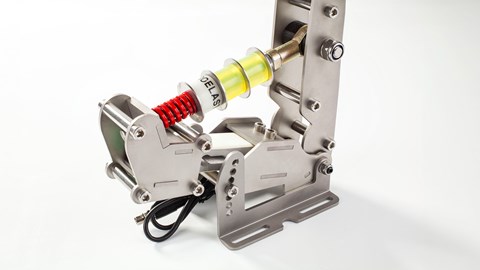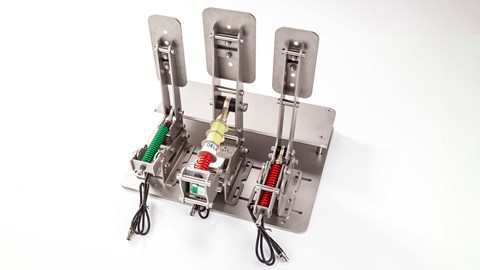► Heavy-duty sim-racing pedals reviewed
► Stainless steel construction, 120kg brake load cell
► Circa £420 purchase price
The RaceGear Lightning complete pedal set is aimed at either new sim racers looking to hit the ground running or those searching for an upgrade to an entry-level product. Designed in Czechia by pro sim racer Martin Sirotek, they promise a high-quality feel and experience for a comparatively low price.
RaceGear currently does not produce any other sim racing pedals, so this is the sole offering in its range. Priced at around £420 (plus any import fees), they’re slightly more expensive than – for example – Fanatec’s Clubsport Pedals V3 but considerably cheaper than offerings from Heusinkveld, such as the Sprint and Ultimate sets.
However, unlike the above, RaceGear is an unfamiliar name to even the most diehard sim racing fan, so are its pedals worth spending your money on? Keep reading to find out.
Build quality
The pedals are made from 3mm stainless steel that’s been blasted to give a matte-look finish to the surface. It gives them a strong, functional look, and this is backed up by superb all-round build quality. You won’t find any rough edges or flimsy elements to the main pedal set, although the plastic control box doesn’t look or feel quite as premium.

It’s also worth noting that the complete set of pedals is very heavy and weighs around 12kg. You can bolt them directly to your rig or use the base plate from the RaceGear. However, when bolting the base plate to our Next Level Racing rig, we had to elevate the plate slightly to stop the bolts for the pedals and heel plate from causing an obstruction. This was done fairly easily using stand-off spacers, yet the installation process has the potential to be more involving than alternative pedal sets.
Due to the weight of the pedals, we’d also recommend only purchasing them if you have a very sturdy and rigid rig. Whereas you might be able to get away with using (the much lighter) Fanatec Clubsport V3 pedals with a cheaper, less heavy-duty rig, the RaceGear’s weight exacerbates any flex in your set-up.
You can adjust the throw, stiffness and angle of the throttle, while the clutch only allows you to change the latter. The pedal faces can also be adjusted; we moved them down owing to how large the pedals are (those with smaller feet may find the pedals too big regardless). Meanwhile, the brake pedal angle can be adjusted, as can the stiffness using the brake pedal performance pack (less than £20).
What are they like to use?
It took a while to get the pedals set up correctly, but once they were, the overall quality of the product was evident – the brake pedal (120kg loadcell) undoubtedly being the highlight. We elected not to change the stiffness beyond its standard setting and it didn’t take long for us to start feeling confident on the brakes during races.
The travel is short but still noticeable and there’s a firm yet cushioned feel to the initial press of the pedal that then reveals plenty of detail as you go searching for the limit under braking. Martin at RaceGear, reckons that part of the reason for the quality and feel of the brake pedal is down to the larger than average size which introduces greater leverage and therefore feel.

We were able to drive a number of cars (some with ABS, some without) and feel like we could not only gain time, but also get a better overall experience. In short, it’s a fantastic brake pedal that, for many, will be reason enough to buy the pedals all on its own.
The clutch and throttle pedals (both 20kg loadcell), meanwhile, are more what you’d expect at this price point. The latter is perfectly usable, yet we’d like to see a little more tactility and precision if we’re being fussy. Meanwhile, the clutch is very straightforward and works well enough, yet it’s a shame you can adjust the throw like you can on the throttle. Something else that did surprise us about all three pedals is that – despite appearances – the stainless steel surface provides enough grip even when wearing socks.
Any downsides?
We’ve already mentioned that it took a while to get the pedals set up and part of this was to do with dialling out the electromagnetic interference (EMI). This isn’t unique to the RaceGear pedals – and indeed their own software is perhaps a little too honest in highlighting the raw inputs – yet the grounding process is more involving than on other pedal sets.
Without proper grounding, the EMI was distorting the signals from the pedals to the PC and thus impacting how they run. We suspect one of the main causes of interference was from our Fanatec CSL DD wheelbase as switching it off removed the issue. Thankfully RaceGear is aware of this and provides a video guide on how to use the software to tune it out, as well as supplying grounding cables for the hardware – however, this is something you do not need to do on many rival pedal sets.

Once sorted, the only real disappointment is that you may need to calibrate out the first few millimetres of pedal travel in order to remove any signs of interference – not the end of the world, but perhaps not what you’d expect. Otherwise, the software is straightforward to use and allows you to shape the pedal curves (very handy for cars without ABS) – a feature that Fanatec Clubsport pedals do not offer.
Price and competition
As mentioned, the £420 price tag of the RaceGear pedals compares very favourably to rivals, given the level of quality on offer. Moza Racing CRP Pedals, Simagic P1000 and Fanatec Clubsport V3s are in the same ballpark for price, while Logitech Pro Racing Pedals and Simjack Pros come in at less.
Verdict
There’s no shortage of sim racing pedals to choose from, yet the RaceGear Lightning pedal set still feels like a welcome addition to the market. For those looking for a sturdy, heavy-duty product, the sheer size and weight of the RaceGear pedals set them apart. The fantastic brake pedal is another major plus point, as is the price that puts them in right in contention if you were considering more mainstream Fanatec or Logitech products.
We would like to see greater user-friendliness in the installation process (especially when it comes to dialling out EMI) plus the throttle and clutch could don’t live up to the superb brake pedal, yet that doesn’t stop this pedal set from being an excellent choice for the competitive sim racer looking to gain lap time and and a better experience.
Verdict score: 4/5
Pros:
• Fantastic build quality
• Brake feel is excellent
• Great value-for-money
Cons:
• You’ll need to dial out electromagnetic interference
• Ensure your rig can handle them
Who tested it?
James Dennison is the Head of Automotive Video for CAR, but when he’s not in front of camera he’s a keen racer and sim racer. Having raced (virtually) since he was four years old, he’s seen his fair share of sim racing products over the years and is rated in the top 1% of drivers globally on the popular sim platform, iRacing.
How this product was tested
We tested this product on the iRacing sim racing platform using a variety of cars, tracks and conditions. We used the product with a Next Level Racing GT track rig and Fanatec CSL DD wheel base.
Just so you know, whilst we may receive a commission or other compensation from the links on this website, we never allow this to influence product selections – read why you should trust us